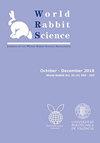兔出血性疾病:新近一株高致病性GI.2/RHDV2/b毒株的实验研究及疫苗效力评价
IF 1.3
4区 农林科学
Q3 AGRICULTURE, DAIRY & ANIMAL SCIENCE
引用次数: 8
摘要
2010年,一种属于新的GI.2基因型的兔出血症病毒(RHDV)变体在法国被发现,并在全球迅速传播。由于抗原差异,包括G1.2菌株在内的新疫苗已经被开发出来,以提供足够的保护。最近报道了循环菌株的致病性增加。本实验研究的目的是描述高致病性GI.2/RHDV2/b分离株(2017)的感染特征,并评估Filavac VHD K C+V疫苗(Filavie)对该菌株的效力。用推荐剂量的疫苗接种4周龄和10周龄的无特定病原体的兔。7天后,对对照组和接种疫苗的兔子进行攻击并进行14天的临床监测。对所有动物进行尸检,并对血液、器官和尿液进行取样,进行定量逆转录聚合酶链式反应(RT-qPCR)分析。在成年组中,定期进行鼻腔和直肠拭子检查,并在死亡后收集粪便以监测RNA的脱落。在对照组中,激发菌株在接种后31至72小时诱导急性RHD,试剂盒的死亡率为100%,成年兔的死亡率为89%。除了试剂盒中的平均死亡时间较短外,不同年龄组之间观察到相似的临床症状和病变。疫苗接种显著预防了所有死亡、临床症状、血清中病毒RNA的检测以及试剂盒和成年兔的大体病变。在成年组中,我们还证明了疫苗通过鼻结膜和直肠途径显著防止可检测的RNA脱落。激发后两周,通过PCR在接种疫苗的成年兔的肝、脾、肺、肾、粪便和尿液中未检测到RNA拷贝。试剂盒的研究结果相似,只是少数兔子的肝脏和脾脏中存在非常低水平的RNA。这些数据表明,免疫预防了任何显著的病毒增殖和/或允许快速清除。我们得出的结论是,尽管GI.2/RHDV2/b毒株进化迅速,但疫苗提供的保护仍然足够。在一些国家,在GI.1和GI.2基因型共存的情况下,随着多种重组病毒的传播,疫苗接种应基于两种基因型菌株的关联。本文章由计算机程序翻译,如有差异,请以英文原文为准。
Rabbit haemorrhagic disease: experimental study of a recent highly pathogenic GI.2/RHDV2/b strain and evaluation of vaccine efficacy
In 2010, a variant of the rabbit haemorrhagic disease virus (RHDV) belonging to a new GI.2 genotype was identified in France and rapidly spread worldwide. Due to antigenic difference, new vaccines including G1.2 strains have been developed to confer adequate protection. An increase in the pathogenicity of the circulating strains was recently reported. The objective of this experimental study was to characterise the infection with a highly pathogenic GI.2/RHDV2/b isolate (2017) and assess the efficacy of Filavac VHD K C+V vaccine (Filavie) against this strain. Four and 10-wk-old specific pathogen-free rabbits were inoculated with a recommended dose of vaccine. After 7 d, controls and vaccinated rabbits were challenged and clinically monitored for 14 d. All animals were necropsied and blood, organs and urine were sampled for quantitative reverse transcription polymerase chain reaction (RT-qPCR) analysis. In adult groups, regular nasal and rectal swabbing were performed, and faeces were collected after death to monitor RNA shedding. In control groups, the challenge strain induced acute RHD between 31 and 72 h post-inoculation, with a mortality rate of 100% for kits and 89% for adult rabbits. Except for a shorter mean time to death in kits, similar clinical signs and lesions were observed between age groups. The vaccination significantly prevented all mortality, clinical signs, detection of viral RNA in serum and gross lesions in kits and adult rabbits. In adult groups, we also demonstrated that vaccine significantly protected from detectable RNA shedding via naso-conjunctival and rectal routes. Two weeks after challenge, RNA copies were not detected by PCR in the liver, spleen, lungs, kidneys, faeces and urine of vaccinated adult rabbits. The findings for kits were similar, except that very low levels of RNA were present in the liver and spleen of a few rabbits. These data show that immunisation prevented any significant viral multiplication and/or allowed a rapid clearance. We concluded that, despite the quick evolution of GI.2/RHDV2/b strains, the protection conferred by the vaccine remains adequate. In the context of coexistence of both GI.1 and GI.2 genotypes in some countries, with the circulation of multiples recombinant viruses, the vaccination should be based on the association of strains from both genotypes.
求助全文
通过发布文献求助,成功后即可免费获取论文全文。
去求助
来源期刊

World Rabbit Science
农林科学-奶制品与动物科学
CiteScore
1.70
自引率
25.00%
发文量
22
审稿时长
>36 weeks
期刊介绍:
World Rabbit Science is the official journal of the World Rabbit Science Association (WRSA). One of the main objectives of the WRSA is to encourage communication and collaboration among individuals and organisations associated with rabbit production and rabbit science in general. Subject areas include breeding, genetics, production, management, environment, health, nutrition, physiology, reproduction, behaviour, welfare, immunology, molecular biology, metabolism, processing and products.
World Rabbit Science is the only international peer-reviewed journal included in the ISI Thomson list dedicated to publish original research in the field of rabbit science. Papers or reviews of the literature submitted to World Rabbit Science must not have been published previously in an international refereed scientific journal. Previous presentations at a scientific meeting, field day reports or similar documents can be published in World Rabbit Science, but they will be also subjected to the peer-review process.
World Rabbit Science will publish papers of international relevance including original research articles, descriptions of novel techniques, contemporaryreviews and meta-analyses. Short communications will only accepted in special cases where, in the Editor''s judgement, the contents are exceptionally exciting, novel or timely. Proceedings of rabbit scientific meetings and conference reports will be considered for special issues.
World Rabbit Science is published in English four times a year in a single volume. Authors may publish in World Rabbit Science regardless of the membership in the World Rabbit Science Association, even if joining the WRSA is encouraged. Views expressed in papers published in World Rabbit Science represent the opinion of the author(s) and do not necessarily reflect the official policy of the WRSA or the Editor-in-Chief.
 求助内容:
求助内容: 应助结果提醒方式:
应助结果提醒方式:


